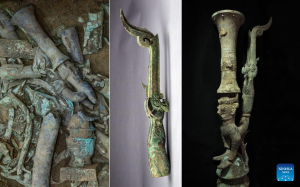First discovered in the 1920’s, China’s Sanxingdui site provides one of the greatest archaeological finds of the 20th century. Located in China’s Sichuan province, it houses relics of the ancient kingdom of shu, which flourished more than 3,000 years ago before mysteriously disappearing. The site was discovered when a local farmer who was digging a trench stumbled upon the buried ruins. While the site went mostly untouched for the next 60 years of internal Chinese turmoil, it was rediscovered and explored in 1986 when another set of local workers once again stumbled upon the site. Chinese archaeologists swarmed the site, uncovering a vast trove of artifacts, including urns, vases, and striking masks of gold, bronze, and jade. These artifacts were discovered broken and buried within pits, leading to experts theorizing that they held some sacrificial value. Carbon dating placed these objects as far back as 13,000 bc.
(Sanxingdui Mask)
While excavation and exploration of the site continued for decades, in recent years even more major discoveries have been made. From 2020-2022, Chinese archaeologists uncovered 6 new pits full of over 3,000 new artifacts. These new artifacts help point to the central importance of the Sanxingdui site for the people that lived there over 3,000 years ago. According to Chinese researcher Ran Honglin, the objects “Reflect the early exchange and integration of Chinese civilization”. Among one of the more notable artifacts is a statue featuring a human head upon a snake’s body, with its hands holding a type of ancient drinking vessel known as a Lei. A different type of vessel known as a zun is depicted upon the statue’s head. According to Ran Honglin, the object shows early connections between different cultures. The Human headed snake is typical of other Shu kingdom artifacts, while the two drinking vessels are predominantly associated with the ancient Zhou dynasty of china, possibly showing a connection between the two cultures.
(Sanxingdui Statue)
One of the major questions still being asked by archaeologists regarding the Sanxingdui site regards why it was abandoned. Archaeological evidence shows that while the Kingdom of Shu remained active for centuries later, the Sanxingdui site was abandoned sometime around 1,300-1,200 bc. Many theories exist to attempt to explain why, from earthquakes, to flooding, to war, however as of yet a consensus has not been reached. What is known however, is where the people of Sanxingdui went. In 2001, another archaeological site was discovered only 30 miles away from Sanxingdui. Known as the Jinsha site, the artifacts discovered there were shockingly similar to those found in Sanxingdui, however the dates ranged from 1,200-500 bc, leading to archaeologists theorizing that after the decline of Sanxingdui, the Jinsha site became the new capital of the Kingdom of Shu.
(Jinsha Site Mask)
References
Magazine, S. (2022, June 14). Trove of 13,000 artifacts sheds light on enigmatic Chinese civilization. Smithsonian.com. Retrieved November 12, 2022, from https://www.smithsonianmag.com/smart-news/trove-of-13000-artifacts-sheds-light-on-enigmatic-chinese-civilization-180980254/
Weiss, D. (n.d.). Seismic shift. Archaeology Magazine. Retrieved November 12, 2022, from https://www.archaeology.org/issues/169-1503/trenches/2986-trenches-china-sanxingdui-civilization
NBCUniversal News Group. (2022, June 15). Ancient artifacts found in Sanxingdui, China help illuminate Shu Kingdom. NBCNews.com. Retrieved November 12, 2022, from https://www.nbcnews.com/news/world/sanxingdui-china-archaeology-artifacts-sacrificial-pits-shu-kingdom-rcna33643
How artefacts are being protected at the sanxingdui ruins in China. South China Morning Post. (2022, July 26). Retrieved November 12, 2022, from https://www.scmp.com/news/china/science/article/3186667/how-artefacts-are-being-protected-sanxingdui-ruins-china






